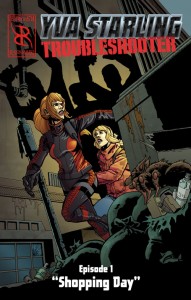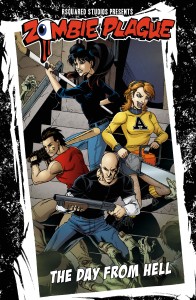Creator interview: Brian Roe and Ronda Pattison
For many artists wanting to break into an industry—be it visual art or writing—the popular belief is you need to be in New York City or Los Angeles to succeed. But in this age of constant connection, any landscape is a viable canvas for creation. For Brian Roe and Ronda Pattison, who together make up RSquared Studios—a comic studio focused on providing coloring services, as well as lettering, illustration, and writing—that landscape is Indianapolis, Indiana.
It hasn’t been easy, but the duo have two comics to showcase their efforts—Zombie Plague, a survival story, and Yva Starling, Troubleshooter, a space adventure. Aiding in those efforts is a strong comic pedigree that includes work with some of the top artists and publishers in the business.
Pattison—who was nominated for an Eisner award for her color work in 2008, a Shuster award in 2010, and recently praised by Kevin Eastman and Tom Waltz for her color work on their Teenage Mutant Ninja Turtles book during an interview with Comic Book Resources—began working for a studio called Digital Chameleon followed by a stint with Sno-Cone. Both studios did work for multiple comic companies including Marvel, DC, and Dark Horse. Pattison went solo in the mid-2000s, first working as a colorist for Dark Horse books such as Star Wars titles Dark Times and The Clone Wars. She’s contributed colors to Marvel books such as Wolverine and a Spider-Man miniseries. For the past several years most of her work has been for IDW and such books as TNMT, Godzilla, and many John Byrne projects.
In 2008 she met Brian Roe, a graphic designer whose background was in tabletop gaming and miniature sculpting. He began working with Pattison on her comics coloring and they soon decided to form RSquared Studios. “I’m great at execution. He’s great at ideas,” Pattison, said. “He had so many great ideas and I always wanted to branch out to creating my own stuff. I had the contacts and industry knowledge and he had 1001 story ideas.”
Their latest comic creation is Yva Starling, Troubleshooter, which focuses on a freelance space gunslinger who takes odd jobs while trying to avoid a set of dangerous assassins. Yva began life as a sort of mascot for Pattison, a character she could use in her portfolio and place on business cards. With Roe’s help, however, Yva soon grew beyond just an image. Pattison knew the character was an action/ sci-fi heroine, but Roe helped flesh out the character’s backstory, inspired by such old-time TV westerns as Have Gun – Will Travel and Wanted: Dead or Alive. Once the basics were written down, the rest of Yva’s story quickly fell into place. Pattison wanted Yva to be a female superheroine but not one that looked like all the rest. “I didn’t want Power Girl,” she says. “I didn’t want sexist—there was going to be no butt shots and no cleavage shots. And I have this thing about how female superheroes are dressed—there was not going to be high heels and not going to be hair in her face. I wanted someone real. She was going to be wearing pants, boots, and her hair was going to be in a ponytail.”
“[Yva is] incredibly tough, incredibly resourceful, but she’s also compassionate and a nice person,” Roe says. “When I started writing about her I specifically tried to avoid standard stereotypes for female characters. I didn’t want her to be an ice queen—I hate that trope that if a woman is tough she has to be soulless.”
There is also an companion Yva Starling paper doll book, drawn by Pattison and inspired by her childhood days designing clothes for Betty and Veronica. The clothing descriptions give clues to Starling’s skillset and background.
Beyond Yva Starling, Troubleshooter, the duo has also worked on Zombie Plague, a project that borrows from both artists’ backgrounds—comics and gaming. Zombie Plague started as a board game—a battle of survival between four teens and a battalion of slow moving zombies. The object the game is to secure your shelter and outlast the evil dead. Or, if you play the zombie squadron, to break through the teen’s barricades and start feeding. Roe never had the time or money to devote to the game like he really wanted, so when he first met Pattison, she told him everything was there for a good product, but the focus shifted from game to comic. “[Roe] decided to put the game on hold because he thought zombies were done, and then everything proved us wrong,” she says.
Just like with Yva Starling, Roe built backstories for the game’s characters. He was also motivated by how many survival stories spin around constant betrayal. “I kind of detest most modern zombie stories,” he says. “And I’ve always detested the idea how when these things happen everyone immediately turns on each other. Historically that’s not always the case. A lot of the time if you look at natural disasters people actually ban together more than they go into the looting/ murdering phase. So if you have four friends who you go to school with every day, you aren’t going to immediately turn on one another. If you do, you are already a sociopath.”
Roe doesn’t understand why more creators don’t try to cross their creations over into other genres. “If they can draw a comic they can do an illustration for a game,” he says. “It seems like everyone has separated off into doing only one of the other.” The first issue of Zombie Plague comes with a set of rules to play the game. All the other needed accessories can be downloaded and printed out from the RSquared website. Miniatures of the four characters and various zombies will also be available.
With a couple of projects already out in the world, Roe and Pattison hope to continue creating their own comics and a tabletop game may not be far away. “You have to keep producing things and that’s not been easy for us,” Roe says. “Comics are a sequential medium. [Readers] want issues one through 50.” As an independent studio in the middle of Indiana, Roe is trying to figure out a cost effective way to keep new stories in readers’ hands. He looks back to the pulp writers who produced Doc Savage and The Shadow. “I love that idea of working class writing. People need to read the stories and be happy, and you need to get the stories to them to make money. The guy who wrote Doc Savage was a superfast writer to the point he was destroying type writers. That’s awesome.”





